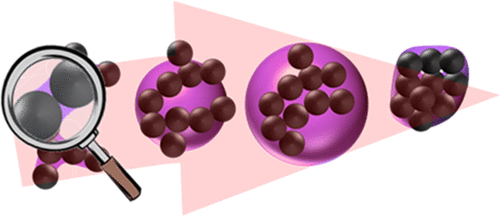当前位置:
X-MOL 学术
›
Environ. Sci. Technol.
›
论文详情
Our official English website, www.x-mol.net, welcomes your
feedback! (Note: you will need to create a separate account there.)
Vapor Condensation and Coating Evaporation Are Both Responsible for Soot Aggregate Restructuring
Environmental Science & Technology ( IF 10.8 ) Pub Date : 2021-06-15 , DOI: 10.1021/acs.est.1c02391 Ogochukwu Y Enekwizu 1 , Ali Hasani 2 , Alexei F Khalizov 1, 2
Environmental Science & Technology ( IF 10.8 ) Pub Date : 2021-06-15 , DOI: 10.1021/acs.est.1c02391 Ogochukwu Y Enekwizu 1 , Ali Hasani 2 , Alexei F Khalizov 1, 2
Affiliation

|
Fresh soot is made of fractal aggregates, which often appear collapsed in atmospheric samples. A body of work has concluded that the collapse is caused by liquid shells when they form by vapor condensation around soot aggregates. However, some recent studies argue that soot remains fractal even when engulfed by the shells, collapsing only when the shells evaporate. To reconcile this disagreement, we investigated soot restructuring under conditions ranging from capillary condensation to full encapsulation, also including condensate evaporation. In these experiments, airborne fractal aggregates were exposed to vapors of wetting liquids, and particle size was measured before and after coating loss, allowing us to isolate the contribution from condensation toward restructuring. We show the existence of three distinct regions along the path connecting the initial fractal and final collapsed aggregates, where minor restructuring occurs already at zero vapor supersaturation due to capillary condensation. Increasing supersaturation increases the amount of condensate, producing a more notable aggregate shrinkage. At even higher supersaturations, the aggregates become encapsulated, and subsequent condensate evaporation leaves behind fully compacted aggregates. Hence, for wetting liquids, minor restructuring begins already during capillary condensation and significant restructuring occurs as the coating volume increases. However, at this time, we cannot precisely quantify the contribution of condensate evaporation to the full aggregate compaction.
中文翻译:

蒸汽冷凝和涂层蒸发都对烟灰骨料重组负责
新鲜煤烟由分形聚集体组成,在大气样本中经常出现坍塌。大量工作得出的结论是,坍塌是由液体外壳引起的,因为它们是由烟尘聚集体周围的蒸汽冷凝形成的。然而,最近的一些研究认为,即使被贝壳吞没,烟灰仍然是分形的,只有在贝壳蒸发时才会坍塌。为了调和这种分歧,我们研究了从毛细管冷凝到完全封装的条件下的烟尘重组,还包括冷凝水蒸发。在这些实验中,空气中的分形聚集体暴露于润湿液体的蒸汽中,并在涂层损失前后测量粒径,使我们能够隔离冷凝对重组的贡献。我们展示了沿着连接初始分形和最终坍塌聚集体的路径存在三个不同区域,其中由于毛细管冷凝,在零蒸汽过饱和度处已经发生了轻微的重组。增加过饱和度会增加冷凝物的量,从而产生更显着的骨料收缩。在更高的过饱和度下,聚集体被包裹起来,随后的冷凝水蒸发留下完全压实的聚集体。因此,对于润湿液体,在毛细管冷凝过程中已经开始发生轻微的重组,随着涂层体积的增加,会发生显着的重组。然而,此时,我们无法精确量化冷凝蒸发对完全集料压实的贡献。由于毛细管冷凝,蒸汽过饱和度为零时已经发生了轻微的重组。增加过饱和度会增加冷凝物的量,从而产生更显着的骨料收缩。在更高的过饱和度下,聚集体被包裹起来,随后的冷凝水蒸发留下完全压实的聚集体。因此,对于润湿液体,在毛细管冷凝过程中已经开始发生轻微的重组,随着涂层体积的增加,会发生显着的重组。然而,此时,我们无法精确量化冷凝蒸发对完全集料压实的贡献。由于毛细管冷凝,在零蒸汽过饱和状态下已经发生了轻微的重组。增加过饱和度会增加冷凝物的量,从而产生更显着的骨料收缩。在更高的过饱和度下,聚集体被包裹起来,随后的冷凝水蒸发留下完全压实的聚集体。因此,对于润湿液体,在毛细管冷凝过程中已经开始发生轻微的重组,随着涂层体积的增加,会发生显着的重组。然而,此时,我们无法精确量化冷凝蒸发对完全集料压实的贡献。在更高的过饱和度下,聚集体被包裹起来,随后的冷凝水蒸发留下完全压实的聚集体。因此,对于润湿液体,在毛细管冷凝过程中已经开始发生轻微的重组,随着涂层体积的增加,会发生显着的重组。然而,此时,我们无法精确量化冷凝蒸发对完全集料压实的贡献。在更高的过饱和度下,聚集体被包裹起来,随后的冷凝水蒸发留下完全压实的聚集体。因此,对于润湿液体,在毛细管冷凝过程中已经开始发生轻微的重组,随着涂层体积的增加,会发生显着的重组。然而,此时,我们无法精确量化冷凝蒸发对完全集料压实的贡献。
更新日期:2021-07-06
中文翻译:

蒸汽冷凝和涂层蒸发都对烟灰骨料重组负责
新鲜煤烟由分形聚集体组成,在大气样本中经常出现坍塌。大量工作得出的结论是,坍塌是由液体外壳引起的,因为它们是由烟尘聚集体周围的蒸汽冷凝形成的。然而,最近的一些研究认为,即使被贝壳吞没,烟灰仍然是分形的,只有在贝壳蒸发时才会坍塌。为了调和这种分歧,我们研究了从毛细管冷凝到完全封装的条件下的烟尘重组,还包括冷凝水蒸发。在这些实验中,空气中的分形聚集体暴露于润湿液体的蒸汽中,并在涂层损失前后测量粒径,使我们能够隔离冷凝对重组的贡献。我们展示了沿着连接初始分形和最终坍塌聚集体的路径存在三个不同区域,其中由于毛细管冷凝,在零蒸汽过饱和度处已经发生了轻微的重组。增加过饱和度会增加冷凝物的量,从而产生更显着的骨料收缩。在更高的过饱和度下,聚集体被包裹起来,随后的冷凝水蒸发留下完全压实的聚集体。因此,对于润湿液体,在毛细管冷凝过程中已经开始发生轻微的重组,随着涂层体积的增加,会发生显着的重组。然而,此时,我们无法精确量化冷凝蒸发对完全集料压实的贡献。由于毛细管冷凝,蒸汽过饱和度为零时已经发生了轻微的重组。增加过饱和度会增加冷凝物的量,从而产生更显着的骨料收缩。在更高的过饱和度下,聚集体被包裹起来,随后的冷凝水蒸发留下完全压实的聚集体。因此,对于润湿液体,在毛细管冷凝过程中已经开始发生轻微的重组,随着涂层体积的增加,会发生显着的重组。然而,此时,我们无法精确量化冷凝蒸发对完全集料压实的贡献。由于毛细管冷凝,在零蒸汽过饱和状态下已经发生了轻微的重组。增加过饱和度会增加冷凝物的量,从而产生更显着的骨料收缩。在更高的过饱和度下,聚集体被包裹起来,随后的冷凝水蒸发留下完全压实的聚集体。因此,对于润湿液体,在毛细管冷凝过程中已经开始发生轻微的重组,随着涂层体积的增加,会发生显着的重组。然而,此时,我们无法精确量化冷凝蒸发对完全集料压实的贡献。在更高的过饱和度下,聚集体被包裹起来,随后的冷凝水蒸发留下完全压实的聚集体。因此,对于润湿液体,在毛细管冷凝过程中已经开始发生轻微的重组,随着涂层体积的增加,会发生显着的重组。然而,此时,我们无法精确量化冷凝蒸发对完全集料压实的贡献。在更高的过饱和度下,聚集体被包裹起来,随后的冷凝水蒸发留下完全压实的聚集体。因此,对于润湿液体,在毛细管冷凝过程中已经开始发生轻微的重组,随着涂层体积的增加,会发生显着的重组。然而,此时,我们无法精确量化冷凝蒸发对完全集料压实的贡献。










































 京公网安备 11010802027423号
京公网安备 11010802027423号